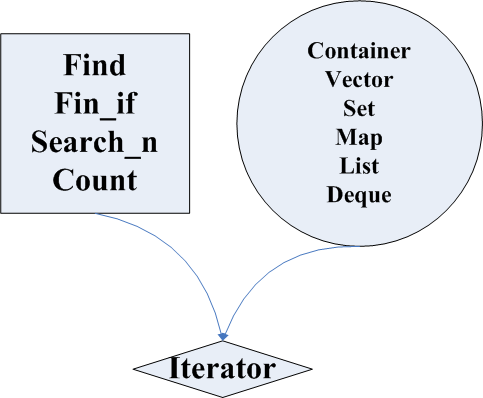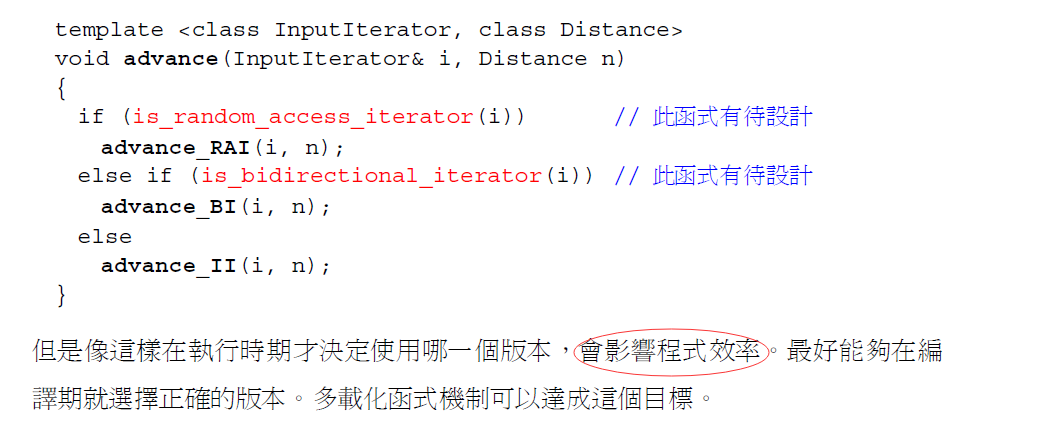c++ stl源码剖析学习笔记(二)iterator
ITERATOR 迭代器
template<class InputIterator,class T>
InputIterator find(InputIterator first,InputIterator last,const T& value)
{
while(first != last && *first != value)
++first;
return first;
}
代码示例
#include <iostream>
#include <vector>
#include <list>
#include <deque>
#include <algorithm>
#include <iostream> using namespace std; int main(int argc, char *argv[])
{
const int arraySize = ;
int ia[arraySize] = {,,,,,,}; vector<int> ivect(ia,ia+arraySize);
list<int> ilist(ia,ia+arraySize);
deque<int> ideque(ia,ia+arraySize); vector<int>::iterator it1 = find(ivect.begin(),ivect.end(),);
if(it1 == ivect.end())
cout << "4 not found." << endl;
else
cout << "4 found. " << * it1 << endl; list<int>::iterator it2 = find(ilist.begin(),ilist.end(),);
if(it2 == ilist.end())
cout << "6 not found. " << endl;
else
cout << "6 found. " << *it2 << endl; deque<int>::iterator it3 = find(ideque.begin(),ideque.end(),);
if(it3 == ideque.end())
cout << "8 not found. " << endl;
else
cout << "8 find " << *it3 << endl; return ;
}
stl中容器有vector\set\list等等等等
算法有find\count等
两者独立 而他们之间的联系便是由iterator进行连接 将两者粘合起来
iterator类似智能指针

智能指针auto_ptr 除了拥有平常指针概念的功能 还具有引用计数功能
通过对该指针指向的元素的引用计数 自动释放元素内存资源 而不必手动调用delete
(auto_ptr 在c++11之后已经被智能指针shared_ptr unique_ptr取代)
示例代码如下
#include <iostream>
#include <vector>
#include <list>
#include <deque>
#include <algorithm>
#include <iostream> using namespace std; template<class T>
class auto_ptr{
public:
explicit auto_ptr(T* p = 0):pointer(p){}
template<typename U>
auto_ptr(auto_ptr<U>& rhs):pointer(rhs.release()){}
~auto_ptr(){ cout << "enter delete status\n";delete pointer;} template<class U>
auto_ptr<T>& operator=(auto_ptr<U>& rhs){
if(this != &rhs) reset(rhs.release());
return *this;
}
T& operator*()const{return *pointer;}
T* operator->()const{return pointer;}
T* get()const{return pointer;} private:
T* pointer;
}; int main(int argc, char *argv[])
{
auto_ptr<string> ps(new string("test"));
cout << *ps << endl;
cout << ps->size() << endl;
return 0;
}
要使用iterator这个智能指针 就需要识别指向的元素的相关信息,比如类别、引用等
代码使用了trait技巧将元素信息提取出来
#include <iostream>
#include <vector>
#include <list>
#include <deque>
#include <algorithm>
#include <iostream>
#include <typeinfo> using namespace std; struct INT{
typedef int value_type;
typedef int difference_type;
typedef int* pointer;
typedef int& reference;
}; struct FLOAT{
typedef float value_type;
typedef float difference_type;
typedef float* pointer;
typedef float& reference;
}; template<class I>
struct Iterator_Traits{
//typedef typename I::iterator_category iterator_category;
typedef typename I::value_type value_type;
typedef typename I::difference_type difference_type;
typedef typename I::pointer pointer;
typedef typename I::reference reference;
}; int main(int argc, char *argv[])
{
std::cout << typeid(Iterator_Traits<INT>::reference).name() << std::endl;
std::cout << typeid(Iterator_Traits<FLOAT>::reference).name() << std::endl; return 0;
}
至此 除了
//typedef typename I::iterator_category iterator_category;
还没解决 其他都解决完毕
iterator_category是什么东西呢?
iterator迭代器也是有类型区分的

那么在实际代码中是如何进行识别呢?
在代码执行时才识别区分 效率太低

#include <iostream>
#include <vector>
#include <list>
#include <deque>
#include <algorithm>
#include <iostream>
#include <typeinfo> using namespace std; //申请五个作为迭代器iterator类别的结构
struct input_iterator_tag_{};
struct output_iterator_tag_{};
struct forward_iterator_tag_:public input_iterator_tag_{};
struct bidirectional_iterator_tag_:public forward_iterator_tag_{};
struct random_access_iterator_tag_:public bidirectional_iterator_tag_{}; struct INT{
typedef input_iterator_tag_ iterator_category;
typedef int value_type;
typedef int difference_type;
typedef int* pointer;
typedef int& reference;
}; struct FLOAT{
typedef output_iterator_tag_ iterator_category;
typedef float value_type;
typedef float difference_type;
typedef float* pointer;
typedef float& reference;
}; template<class I>
struct MyIterator_Traits{
typedef typename I::iterator_category iterator_category;
typedef typename I::value_type value_type;
typedef typename I::difference_type difference_type;
typedef typename I::pointer pointer;
typedef typename I::reference reference;
};
template<typename T,typename Distance>
void test(T t,Distance n){
typename MyIterator_Traits<T>::iterator_category SELECT_TYPE;
test_(t,n,SELECT_TYPE);
} template<typename InputIterator,typename Distance>
void test_(InputIterator i,Distance j,input_iterator_tag_){
cout << "input_iterator_tag_" << endl;
} template<typename InputIterator,typename Distance>
void test_(InputIterator i,Distance j,output_iterator_tag_){
cout << "output_iterator_tag_" << endl;
} int main(int argc, char *argv[])
{
INT i;
FLOAT f;
char c;
test(i,c);
test(f,c); return 0;
}
我们对不同的迭代器 指定不同的tag 这样就会进入到不同的函数中去了
c++ stl源码剖析学习笔记(二)iterator的更多相关文章
- c++ stl源码剖析学习笔记(一)uninitialized_copy()函数
template <class InputIterator, class ForwardIterator>inline ForwardIterator uninitialized_copy ...
- c++ stl源码剖析学习笔记(三)容器 vector
stl中容器有很多种 最简单的应该算是vector 一个空间连续的数组 他的构造函数有多个 以其中 template<typename T> vector(size_type n,cons ...
- STL源码剖析 学习笔记 MiniSTL
https://github.com/joeyleeeeeee97 目录: 第二章 空间适配器 第三章 迭代器 第四章 序列式容器(vector,list,deque,stack,heap,prior ...
- STL源码剖析-学习笔记
1.模板是一个公式或是蓝图,本身不是类或是函数,需进行实例化的过程.这个过程是在编译期完成的,编译器根据传递的实参,推断出形参的类型,从而实例化相应的函数 2. 后续补充-.
- STL源码剖析读书笔记之vector
STL源码剖析读书笔记之vector 1.vector概述 vector是一种序列式容器,我的理解是vector就像数组.但是数组有一个很大的问题就是当我们分配 一个一定大小的数组的时候,起初也许我们 ...
- 重温《STL源码剖析》笔记 第三章
源码之前,了无秘密. --侯杰 第三章:迭代器概念与traits编程技法 迭代器是一种smart pointer auto_Ptr 是一个用来包装原生指针(native pointer)的对象,声明狼 ...
- STL源码剖析读书笔记--第四章--序列式容器
1.什么是序列式容器?什么是关联式容器? 书上给出的解释是,序列式容器中的元素是可序的(可理解为可以按序索引,不管这个索引是像数组一样的随机索引,还是像链表一样的顺序索引),但是元素值在索引顺序的方向 ...
- 重温《STL源码剖析》笔记 第五章
源码之前,了无秘密 ——侯杰 序列式容器 关联式容器 array(build in) RB-tree vector set heap map priority-queue multiset li ...
- 重温《STL源码剖析》笔记 第六、七、八章 next_permutation (字典序)
源码之前,了无秘密 ——侯杰 第六章算法 next_permutation 比如:01342 -> 01423 -> 01432 方法:从尾端开始往前寻找两个相邻的元素,令第一个元素为* ...
随机推荐
- ByteToByte64String、Base64StringToBytes
public string ByteToByte64String(byte[] bytes) { return Convert.ToBase64String(bytes); } public byte ...
- Tag (input) should be an empty-element tag.
因为:<!DOCTYPE html PUBLIC "-//W3C//DTD XHTML 1.0 Transitional//EN" "http://www.w3.o ...
- python3之os、sys
os模块 # 显示当前使用平台:"nt":windows;"posix":Linux >>> os.name 'nt' # 当前工作目录 &g ...
- 单链表查找第i个节点
#include<stdio.h> #include<string.h> #include<stdlib.h> typedef struct Node { char ...
- [Oracle,2018-03-01] oracle常用函数
最近经常用到一些oracle中的函数,今天就总结一些常用的: 一.单行函数 只处理单个行,并且为每行返回一个结果. 1.字符函数 (1)concat(str1,str2)字符串拼接函数 select ...
- oracle入坑日记<一> 安装
学习日记系列(前辈/大神勿喷) 一.下载 下载地址:http://www.oracle.com/technetwork/cn/database/enterprise-edition/downloads ...
- openStack instance error 恢复
cli command下加载openstack超级管理员权限 重设openStack 虚拟机error实例状态即可 nova reset-state instance-id --active
- centos密码策略
centos7密码策略 https://blog.csdn.net/qq_36896749/article/details/80264280 centos7设置密码规则 https://blog.cs ...
- Java笔记一JAVA安装环境变量配置
window系统安装Java 下载Java开发工具包JDK,下载地址:http://www.oracle.com/technetwork/java/javase/downloads/index.htm ...
- Java POI操作Excel注意点
excel的行索引和列索引都是从0开始,而行号和列号都是从1开始 POI·操作excel基本上都是使用索引 XSSFRow对象的 row.getLastCellNum() 方法返回的是当前行最后有效列 ...
